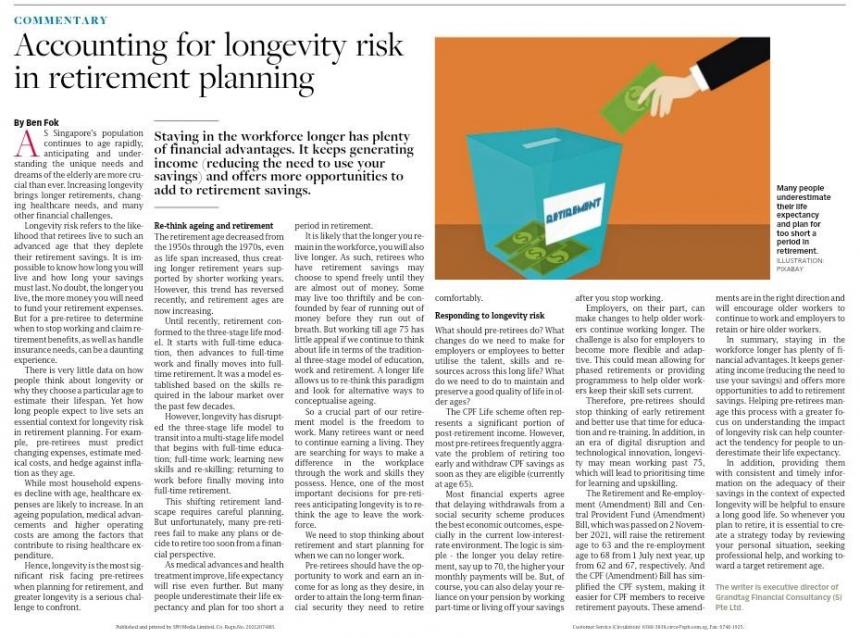You are here
Back to top
News
“Accounting for longevity risk in retirement planning” written by Dr. Ben Fok, featured in the Business Times

[Singapore, Apr 2022] A commentary written by Dr. Ben Fok, Executive Director of Grandtag Financial Consultancy (“GFC”), featured in the Business Times helps readers to get better idea on how to take longevity into account in retirement planning:
As Singapore’s population continues to age rapidly, anticipating and understanding the unique needs and dreams of the elderly are more crucial than ever. Increasing longevity brings longer retirements, changing healthcare needs, and many other financial challenges.
Longevity risk refers to the likelihood that retirees live to such an advanced age that they deplete their retirement savings. It is impossible to know how long you will live and how long your savings must last. No doubt, the longer you live, the more money you will need to fund your retirement expenses. But for a pre-retiree to determine when to stop working and claim retirement benefits, as well as handle insurance needs, can be a daunting experience.
There is very little data on how people think about longevity or why they choose a particular age to estimate their lifespan. Yet how long people expect to live sets an essential context for longevity risk in retirement planning. For example, pre-retirees must predict changing expenses, estimate medical costs, and hedge against inflation as they age.
While most household expenses decline with age, healthcare expenses are likely to increase. In an ageing population, medical advancements and higher operating costs are among the factors that contribute to rising healthcare expenditure.
Hence, longevity is the most significant risk facing pre-retirees when planning for retirement, and greater longevity is a serious challenge to confront.
Staying in the workforce longer has plenty of financial advantages. It keeps generating income (reducing the need to use your savings) and offers more opportunities to add to retirement savings.
Re-think ageing and retirement
The retirement age decreased from the 1950s through the 1970s, even as life span increased, thus creating longer retirement years supported by shorter working years. However, this trend has reversed recently, and retirement ages are now increasing.
Until recently, retirement conformed to the three-stage life model. It starts with full-time education, then advances to full-time work and finally moves into full-time retirement. It was a model established based on the skills required in the labour market over the past few decades.
However, longevity has disrupted the three-stage life model to transit into a multi-stage life model that begins with full-time education; full-time work; learning new skills and re-skilling; returning to work before finally moving into full-time retirement.
This shifting retirement landscape requires careful planning. But unfortunately, many pre-retirees fail to make any plans or decide to retire too soon from a financial perspective.
As medical advances and health treatment improve, life expectancy will rise even further. But many people underestimate their life expectancy and plan for too short a period in retirement
It is likely that the longer you remain in the workforce, you will also live longer. As such, retirees who have retirement savings may choose to spend freely until they are almost out of money. Some may live too thriftily and be confounded by fear of running out of money before they run out of breath. But working till age 75 has little appeal if we continue to think about life in terms of the traditional three-stage model of education, work and retirement. A longer life allows us to re-think this paradigm and look for alternative ways to conceptualise ageing.
So a crucial part of our retirement model is the freedom to work. Many retirees want or need to continue earning a living. They are searching for ways to make a difference in the workplace through the work and skills they possess. Hence, one of the most important decisions for pre-retirees anticipating longevity is to rethink the age to leave the workforce.
We need to stop thinking about retirement and start planning for when we can no longer work.
Pre-retirees should have the opportunity to work and earn an income for as long as they desire, in order to attain the long-term financial security they need to retire comfortably.
Responding to longevity risk
What should pre-retirees do? What changes do we need to make for employers or employees to better utilise the talent, skills and resources across this long life? What do we need to do to maintain and preserve a good quality of life in older ages?
The CPF Life scheme often represents a significant portion of post-retirement income. However, most pre-retirees frequently aggravate the problem of retiring too early and withdraw CPF savings as soon as they are eligible (currently at age 65).
Most financial experts agree that delaying withdrawals from a social security scheme produces the best economic outcomes, especially in the current low-interest-rate environment. The logic is simple - the longer you delay retirement, say up to 70, the higher your monthly payments will be. But, of course, you can also delay your reliance on your pension by working part-time or living off your savings after you stop working.
Employers, on their part, can make changes to help older workers continue working longer. The challenge is also for employers to become more flexible and adaptive. This could mean allowing for phased retirements or providing programmes to help older workers keep their skill sets current.
Therefore, pre-retirees should stop thinking of early retirement and better use that time for education and re-training. In addition, in an era of digital disruption and technological innovation, longevity may mean working past 75, which will lead to prioritising time for learning and upskilling.
The Retirement and Re-employment (Amendment) Bill and Central Provident Fund (Amendment) Bill, which was passed on 2 November 2021, will raise the retirement age to 63 and the re-employment age to 68 from 1 July next year, up from 62 and 67, respectively. And the CPF (Amendment) Bill has simplified the CPF system, making it easier for CPF members to receive retirement payouts. These amendments are in the right direction and will encourage older workers to continue to work and employers to retain or hire older workers.
In summary, staying in the workforce longer has plenty of financial advantages. It keeps generating income (reducing the need to use your savings) and offers more opportunities to add to retirement savings. Helping pre-retirees manage this process with a greater focus on understanding the impact of longevity risk can help counteract the tendency for people to underestimate their life expectancy.
In addition, providing them with consistent and timely information on the adequacy of their savings in the context of expected longevity will be helpful to ensure a long good life. So whenever you plan to retire, it is essential to create a strategy today by reviewing your personal situation, seeking professional help, and working toward a target retirement age.
Read the full article: https://www.businesstimes.com.sg/wealth-investing/accounting-for-longevity-risk-in-retirement-planning

